
A horror film is one that seeks to elicit fear in its audience for entertainment purposes. Horror films additionally aim to evoke viewers' nightmares, fears, revulsions and terror of the unknown or the macabre. Initially inspired by literature from authors such as Edgar Allan Poe, Bram Stoker, and Mary Shelley, horror has existed as a film genre for more than a century. Horror may also overlap with the fantasy, supernatural fiction, and thriller genres.

Horror is a genre of speculative fiction which is intended to frighten, scare, or disgust. Literary historian J. A. Cuddon defined the horror story as "a piece of fiction in prose of variable length... which shocks, or even frightens the reader, or perhaps induces a feeling of repulsion or loathing". It creates an eerie and frightening atmosphere. Horror is often divided into either the psychological horror and supernatural horror sub-genre. Often the central menace of a work of horror fiction can be interpreted as a metaphor for the larger fears of a society. Prevalent elements include ghosts, demons, vampires, werewolves, ghouls, the Devil, witches, monsters, dystopian and apocolyptic worlds, serial killers, cannibalism, psychopaths, cults, dark magic, Satanism, the macabre, gore, and torture.
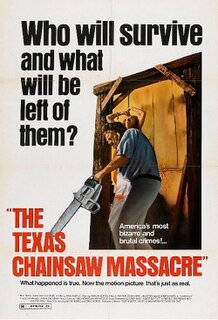
The Texas Chain Saw Massacre is a 1974 American slasher film directed by Tobe Hooper and written and co-produced by Hooper and Kim Henkel. It stars Marilyn Burns, Paul A. Partain, Edwin Neal, Jim Siedow and Gunnar Hansen, who respectively portray Sally Hardesty, Franklin Hardesty, the hitchhiker, the proprietor, and Leatherface. The film follows a group of friends who fall victim to a family of cannibals while on their way to visit an old homestead. The film was marketed as being based on true events to attract a wider audience and to act as a subtle commentary on the era's political climate; although the character of Leatherface and minor story details were inspired by the crimes of murderer Ed Gein, its plot is largely fictional.
A slasher film is a subgenre of horror films involving a killer murdering a group of people, usually by use of bladed tools. Although the term "slasher" may occasionally be used informally as a generic term for any horror film involving murder, film analysts cite an established set of characteristics which set slasher films apart from other horror subgenres, such as splatter films and psychological horror films.
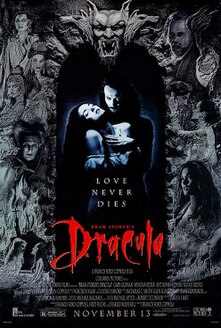
Bram Stoker's Dracula is a 1992 American Gothic horror film directed and produced by Francis Ford Coppola, based on the 1897 novel Dracula by Bram Stoker. It stars Gary Oldman as Count Dracula, Winona Ryder as Mina Harker, Anthony Hopkins as Professor Abraham Van Helsing, and Keanu Reeves as Jonathan Harker.
Because speculative genres explore variants of reproduction, as well as possible futures, SF writers have often explored the social, political, technological, and biological consequences of pregnancy and reproduction.
The Bram Stoker Award for Best Non-Fiction is an award presented by the Horror Writers Association (HWA) for "superior achievement" in horror writing for non-fiction.

LGBT themes in speculative fiction include lesbian, gay, bisexual, or transgender (LGBT) themes in science fiction, fantasy, horror fiction and related genres. Such elements may include an LGBT character as the protagonist or a major character, or explorations of sexuality or gender that deviate from the heteronormative.
The final girl is a trope in horror films. It refers to the last girl(s) or woman alive to confront the killer, ostensibly the one left to tell the story. The final girl has been observed in many films, including The Texas Chain Saw Massacre, Halloween, Alien, Friday the 13th, A Nightmare on Elm Street and Scream. The term was coined by Carol J. Clover in her book Men, Women, and Chainsaws: Gender in the Modern Horror Film (1992). Clover suggested that in these films, the viewer began by sharing the perspective of the killer, but experienced a shift in identification to the final girl partway through the film.
James Daniel Lowder is an American author and editor, working frequently within the fantasy, dark fantasy, and horror genres, and on critical works exploring popular culture.
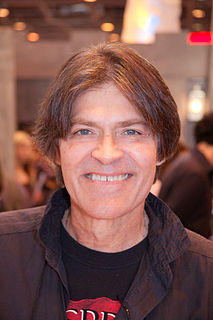
Dallas William Mayr, better known by his pen name Jack Ketchum, was an American horror fiction author. He was the recipient of four Bram Stoker Awards and three further nominations. His novels included Off Season, Offspring, and Red, the later two of which were adapted to film. In 2011, Ketchum received the World Horror Convention Grand Master Award for outstanding contribution to the horror genre.
Carol Jeanne Clover is an American professor of Medieval Studies and American Film at the University of California, Berkeley. Clover has been widely published in her areas of expertise. She is the author of three books. Clover's 1992 book, Men, Women, and Chainsaws: Gender in the Modern Horror Film achieved popularity beyond academia. Clover is credited with developing the "final girl" theory in the horror genre, which has changed both popular and academic conceptions of gender in horror films.

Stephen Jones is an English editor of horror anthologies, and the author of several book-length studies of horror and fantasy films as well as an account of H. P. Lovecraft's early British publications.
Lisa Morton is an American horror author and screenwriter.
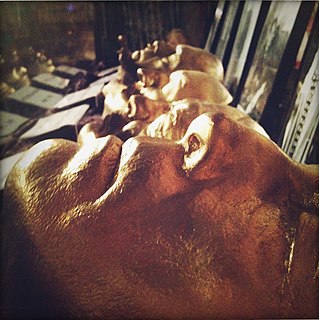
The horror film genre is a movie genre containing multiple subgenres. A goal of this genre includes invoking responses of trepidation and panic from the audience. Critics and researchers claim that these films depict graphically detailed violence, contain erotically or sexually charged situations which verge on becoming pornographic, and focus more on injuring or killing female as opposed to non-female characters. Many also see recurring themes of misfortune for male characters who perform overt masculinity or sexuality. Audience reception is suggested by researchers to be affected by the respective gender representation depicted in these movies.
A list of reference works on the horror genre of film.
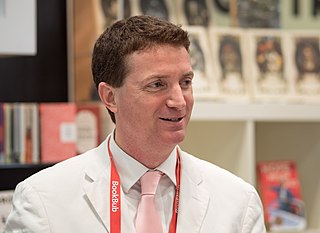
Grady Hendrix is an American author, journalist, public speaker, and screenwriter known for his best-selling 2014 novel Horrorstör. Hendrix lives in Manhattan and was one of the founders of the New York Asian Film Festival.
Centipede Press is an American independent book and periodical publisher focusing on horror, weird tales, crime narratives, science fiction, gothic novels, fantasy art, and studies of literature, music and film. Its earliest imprints were Cocytus Press and Millipede Press.

Jesse Walsh is a fictional character in the A Nightmare on Elm Street franchise. He was created by David Chaskin and portrayed by Mark Patton. Making his debut in A Nightmare on Elm Street 2: Freddy's Revenge in 1985, Jesse became the first male protagonist of the series. In Freddy's Revenge, Freddy enacts a plan to possess Jesse, using his body to kill in the real world, slowly gaining the strength to manifest his form physically. Outside of the films, Jesse has a main role in the novels. Because of the LGBT representation in a mainstream film, Jesse has developed a large fan base in the gay community and has been called a gay icon. Jesse has been observed by some scholars as a variation of the "final girl" slasher film archetype, and has been referred to as a "final boy".
Bibliography of works on Dracula is a listing of non-fiction literary works about the book Dracula or derivative works about its titular vampire Count Dracula.










